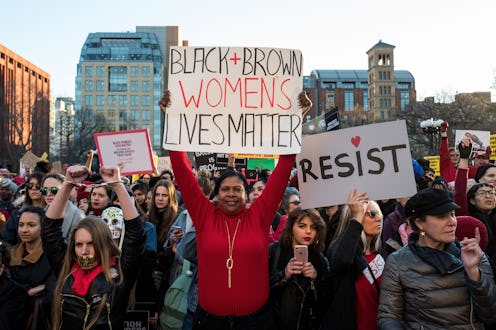
I always thought of the United States as one of the most progressive countries in the world, but sadly, that's not the case when it comes to women's rights, transgender rights, and egalitarianism in general. Thinking about ways the United States is behind on gender equality makes me frustrated because, honestly, it's 2017 and we shouldn't have to worry about getting paid fairly and other issues of everyday sexism.
According to the World Economic Forum, the United States ranks 23 out of the 30 developed nations in terms of gender equality. Even worse, the country's overall ranking fell dramatically from 23rd to 45th place last year. In particular, the percentage of women in the U.S. workforce has dropped, and data indicates that that number may eventually peak at about 47.1 percent in 2025 before dropping to 46.3 percent by 2060. What that means is, men will continue to dominate the workforce indefinitely if we don't start making changes.
A bit of good news: Two decades ago, there weren't any women leading Fortune 500 countries; now, there are quite a few — although the number still pales in comparison to male CEOs. Additionally, reports show that women in the United States are now just as well-educated as men. These are achievements, yes, but at the same time I feel like that's the way it should be — the rule, not the exception.
If our country treated men and women equally, then thousands of people wouldn't have had to participate in the "Day Without A Woman" strike on March 8 or come out to protest against President Donald Trump's policies attacking women (and many other marginalized communities) during the Women's March in January. Here are seven ways in which the United States is falling behind other countries regarding gender equality:
1We're Lacking In Women Leaders
Back in November, many Americans had their fingers crossed, hoping that their country would finally (finally) elect its first woman as president: Hillary Clinton. Unfortunately, that didn't happen. Instead, the United States elected a president whose campaign ran on sexist, racist, and xenophobic rhetoric; he's since gone on to put together the least diverse cabinet in more than three decades, as well as endorse policies like the Global Gag Rule that specifically harm women.
Elsewhere in the world, there are 15 officeholders that are women right now. About half of them are that country's first woman leader ever. Out of 146 nations that the World Economic Forum studied recently, 56 of them have elected a woman to be the head of government for at least a year over the past 50 years.
2There Are Few Legal Protections In Place For Transgender People
In terms of transgender rights, the United States has a long way to go. In 2011, a national survey showed that 64 percent of people whose documents didn't reflect their preferred gender had experienced hiring discrimination. Transgender people in the United States also suffer from a disproportionately high rate of attempted suicide due to bullying and marginalization. Fully 32 states do not have any legal protections in place guarding against LGBTQ discrimination, according to the Human Rights Campaign.
Other countries are several steps ahead in this realm. In early 2015, Ireland became the fourth country in the world to pass a law that lets transgender people who are of 18 years and older to self-identify with their preferred gender (without any medical treatments), which would get reflected on all official documents like passports. For Ireland, that law is called the Gender Recognition Act of 2015 (how awesome is that name, by the way?). Other countries that have passed similar laws include Argentina, Denmark, Colombia, and Malta, an archipelago in the Mediterranean.
3We Don't Have Equal Pay For Equal Work

Yes, people, the gender pay gap is real. In the United States, full-time white women workers make only about 80 percent that which a white man makes — that's a wage gap of 20 percent — and the number drops dramatically for women of color. According to the Institute for Women's Policy Research, the United States probably won't achieve equal pay for equal work until 2059, and it'll take even longer for women of color to get paid what they deserve (2248 for Hispanic women and 2124 for black women). The gender pay gap also varies by state: For instance, women workers are paid 89 percent of what men make in New York, while women in Wyoming get paid only 64 percent of a man's income.
By contrast, Iceland has made equal pay at work a reality. The country just passed a new law requiring companies with at least 25 employees to obtain certification that proves they pay everyone equally regardless of gender, sexuality, race, or nationality. Iceland is the first country ever to do this, proving that gender equality in society is possible, even if it takes baby steps.
4Paid Family Leave Isn't Guaranteed

The United States is special in that it's the only high-income, developed country that doesn't require businesses to provide new mothers with paid leave. It's one of four countries total that do not provide this benefit. Additionally, paid family leave for all parents is becoming increasingly common in countries that recognize that it's equally important for people of all genders to have time with their newborns, not just women. Out of 41 nations in the world, the United States is the only country that doesn't guarantee people of all genders paid family leave. Nations that do include Bulgaria, Japan, Germany, Korea, Spain, Australia, Denmark, Canada, Romania, Israel, Mexico, the United Kingdom, Turkey — the list goes on and on.
5We Have Yet To Sign CEDAW
In 1979, the United Nations passed the Convention on the Elimination of Discrimination Against Women, or CEDAW. Also known as an "international bill of rights for women," CEDAW is a global treaty focused on ending gender discrimination and sexual violence. Out of the 193 members of the United Nations, only seven have not adopted CEDAW, including Iran, Sudan, and the United States. The law protects women's rights in pretty every sector, from education to employment to health care. I imagine if the United States adopted CEDAW, then our performance in national gender equality would improve drastically.
6Fewer Women Run Businesses
Women across the globe are much less likely to hold leadership positions at the companies where they work, but the numbers are lower in the United States than in other regions. Overall, about 24 percent of senior positions are held by women. China, South Africa, and Brazil are just a few of the countries where women make up 30 percent of senior management, the highest percentage compared to other countries.
In the United States, however, only about 15 percent of executive positions are held by women. Only 17 percent of Fortune 500 board members are women, and there are no women CEOs in financial services or health care.
7STEM Fields Are Dominated By Men

Finally, the United States has fewer women practicing in the STEM space than women in other countries. The participation rate of women in STEM is less than 30 percent in the United States (that includes fields like physics and engineering). For instance, 35 percent of chemists are women and only about 8 percent of mechanical engineers are women. Thus, even though women are becoming more educated than men, there's a gender disparity in the fields they choose. It seems as though the STEM fields are still a boy's club.
On the other hand, Mexico has more women with degrees in computer science than any other country (South Africa is not far behind). Girls living in Qatar, Jordan, and the United Arab Emirates reported feeling more confident about their math skills than boys, although those are the only three countries where that's true.
So what does all of this say about our rankings in gender equality? I have three words: Step it up, USA.